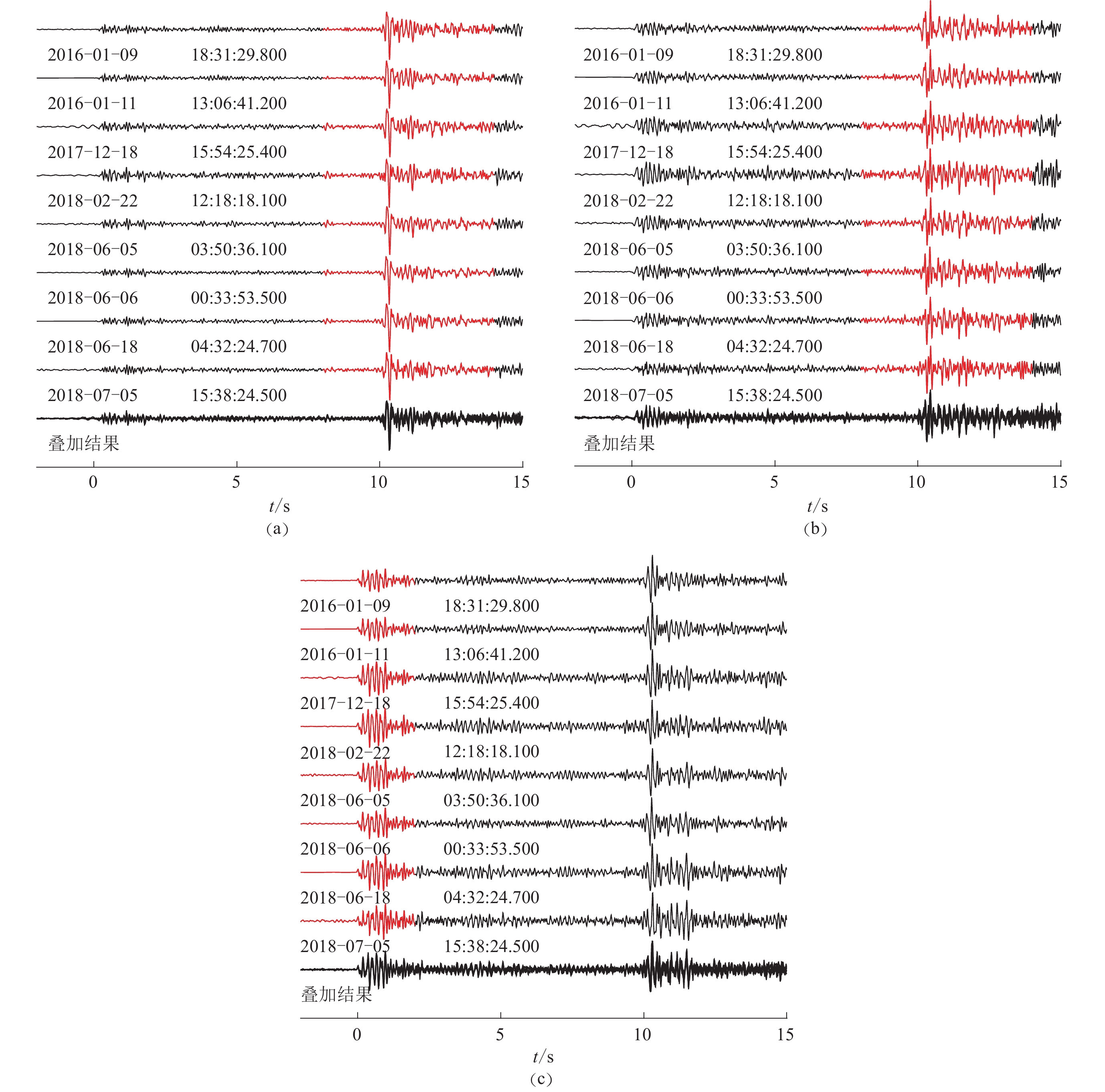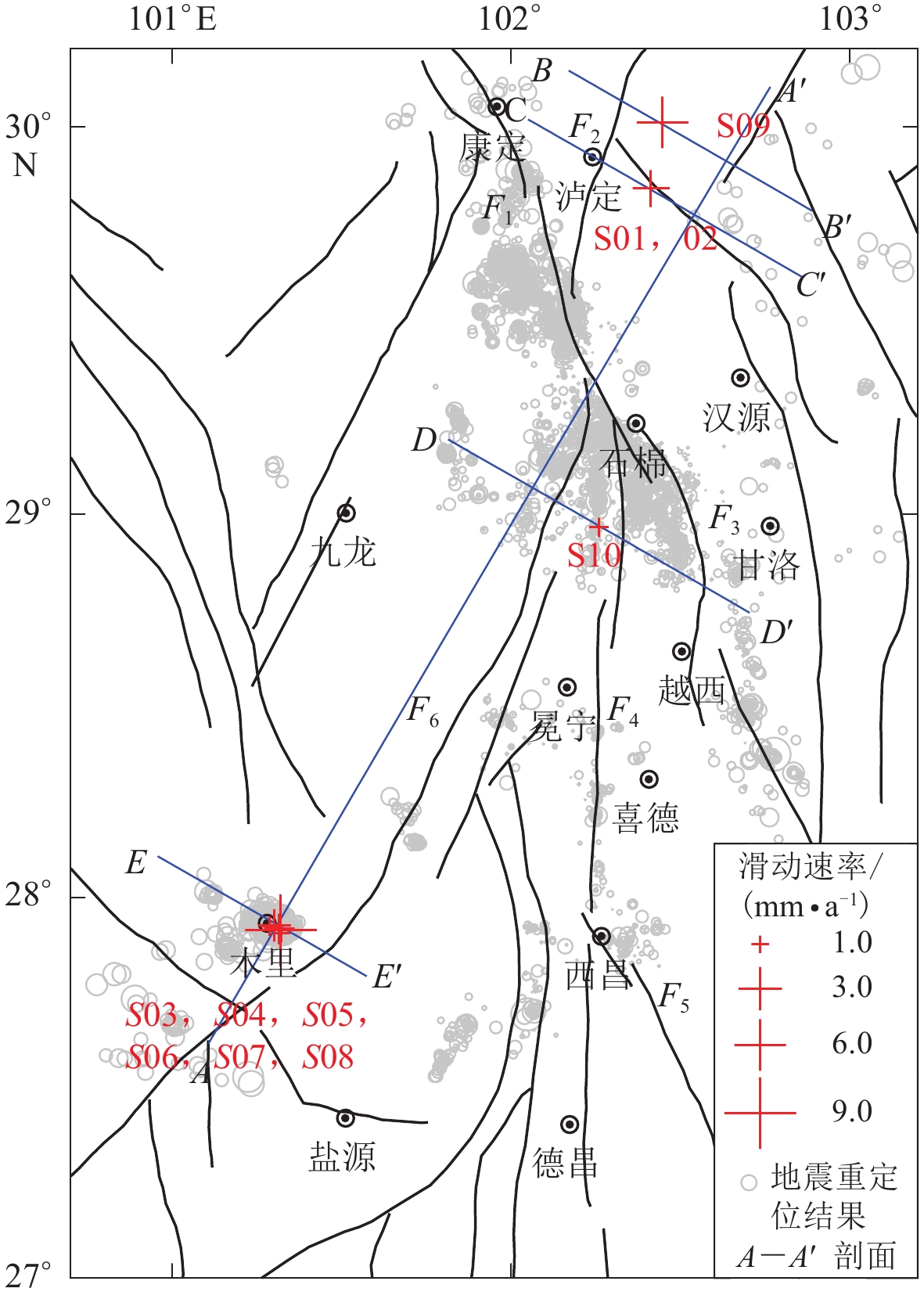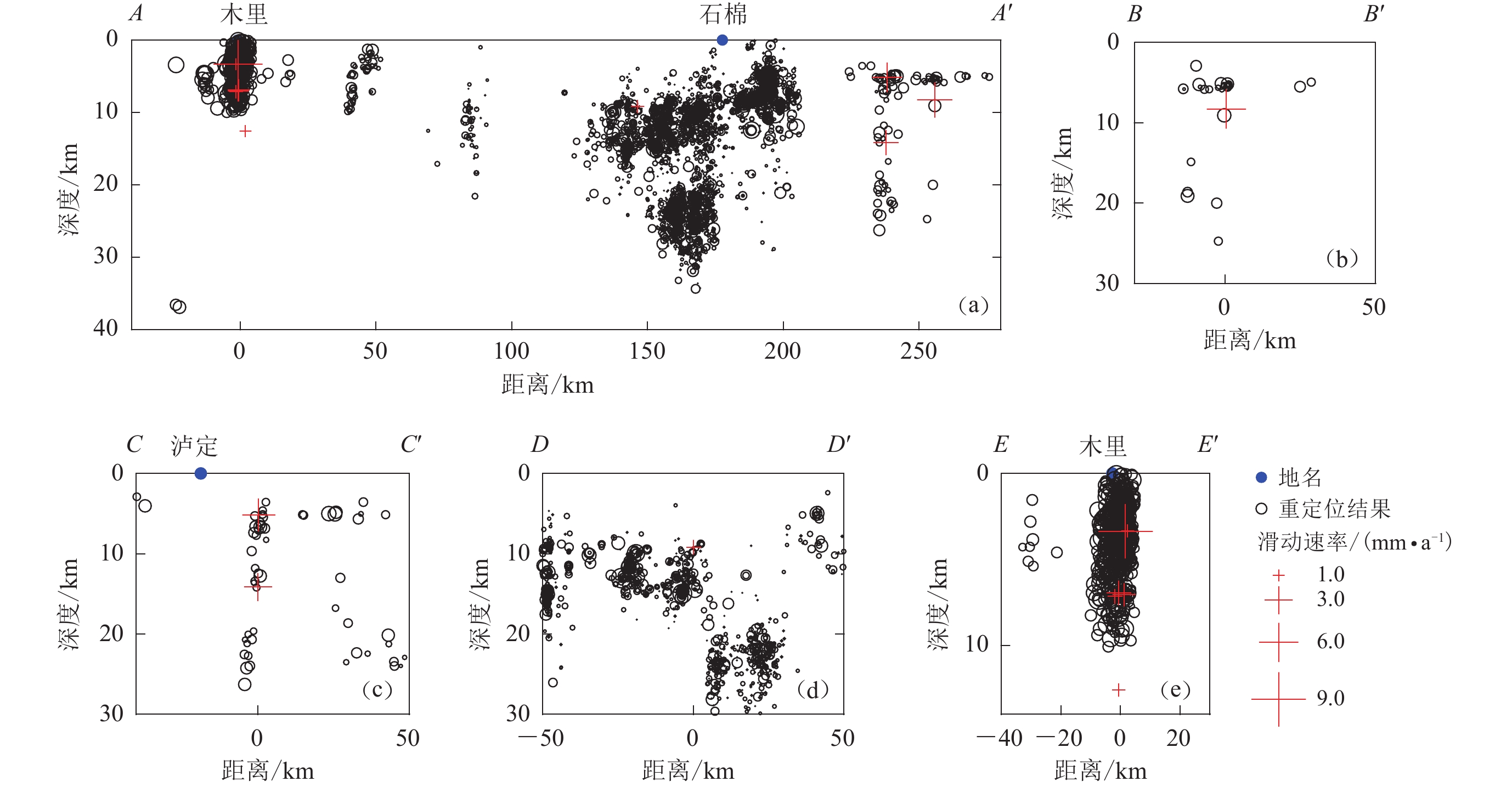Deep slip rates in the Anninghe fault and its surrounding regions according to repeating earthquakes
-
摘要: 基于西昌流动台阵和安宁河断裂带附近固定台站2013—2019年记录的宽频带地震波形资料,利用波形互相关方法进行相似地震识别,同时对P,S震相到时进行校正。结合S−P相对到时差约束地震相对距离的方法,在安宁河断裂带及其周边地区识别得到10组重复地震。对研究区内近震事件和重复地震分别进行重定位,并根据重复地震发震时间间隔计算断裂带深部滑动速率。结果显示:汶川—茂县断裂带西南段滑动速率约为4.37—6.09 mm/a;安宁河断裂带北段滑动速率约为2.30 mm/a;木里地区滑动速率在2.03—8.46 mm/a之间。结合已有研究成果,推测汶川—茂县断裂西南段处于持续蠕滑状态,与孕震凹凸体附近的断层运动特征相符,暗示该区可能存在发生强震的风险;由重复地震和地震重定位结果推测安宁河断裂带具有北段蠕滑、南段闭锁的特征;木里地区浅部地震事件数量多于深部,且浅部滑动速率高于深部,符合水库诱发地震的特征。
-
关键词:
- 重复地震 /
- 深部滑动速率 /
- 安宁河断裂 /
- 汶川—茂县断裂西南段 /
- 西昌流动台阵
Abstract: Based on broadband seismic data recorded by the Xichang Array and permanent seismic stations near the Anninghe fault from 2013 to 2019, similar earthquake clusters were identified by means of waveform correlation and the correction of P- and S-wave arrival times. By constraining interevent distances based on the difference between S- and P-wave arrival times, 10 groups of repeating earthquakes were identified in the Anninghe fault and its surrounding regions. Local events and repeating earthquakes in the studied area were relocated, and the recurrence interval of repeating earthquakes was used to estimate deep slip rates of the fault. It was found that slip rates in the southwestern section of the Wenchuan−Maoxian fault ranged from 4.37 to 6.09 mm/a. The slip rate in the northern segment of the Anninghe fault was 2.30 mm/a, and the slip rate in the Muli region ranged from 2.03 to 8.46 mm/a. It was thus inferred that the southwestern segment of the Wenchuan−Maoxian fault is continuously creeping, which is consistent with fault movements near seismogenic asperities. Therefore, a strong earthquake may occur in this area. Based on the identification of repeating earthquakes and earthquake relocation, it was concluded that the northern section of the Anninghe fault is creeping, while its southern section is locked. In the Muli region, shallow seismic events outnumber deep seismic events, and the shallow slip rate is higher than the deep slip rate, which is consistent with reservoir-induced seismicity. -
-
图 2 地震对破裂面重叠示意图(修改自 Li et al,2011)
Figure 2. Overlap of the source ruptures (modified from Li et al,2011)
图 3 重复地震组S09 在 XGP 台站记录的东向(a)、北向(b)和垂向(c)分量的归一化波形
直达 P 波在 0 时刻对齐,各通道图中最下方波形为该通道全部波形的叠加。用于互相关 计算的波段被标红
Figure 3. Normalized EW component (a),NS component (b) and vertical component (c) waveforms of repeating earthquake group S09 recorded in XGP permanent station
The P phases are aligned at time zero,the bottom traces in the three channels display the stacked waveforms,and the bands marked red are used to calculate cross-correlation
表 1 10组重复地震及其对应的深部滑动速率
Table 1 Deep slip rate computed from 10 repeating earthquake groups
地震组 发震时间(UTC) 北纬/° 东经/° 震源深度/km 事件次数 ML 滑动速率/(mm·a−1) 年-月—年-月 S01 2013-05—2014-09 29.841 9 102.413 0 14.155 3 3 1.4—1.8 4.37±0.65 S02 2013-06—2014-11 29.844 7 102.417 7 5.167 0 3 1.5—2.4 5.13±2.95 S03 2014-05—2017-11 27.906 3 101.323 0 3.333 0 3 1.8—2.8 2.03±1.54 S04 2014-05—2017-12 27.915 9 101.320 6 3.361 3 12 1.6—2.8 8.46±2.34 S05 2014-05—2017-09 27.918 9 101.316 1 7.046 3 5 1.7—2.4 3.59±1.98 S06 2014-05—2017-12 27.947 4 101.314 5 12.582 0 3 1.8—2.8 2.06±0.90 S07 2014-08—2016-11 27.926 5 101.286 5 7.150 0 3 1.7—1.8 2.34±1.42 S08 2014-10—2016-03 27.928 4 101.302 3 6.934 5 3 1.7—2.6 3.84±2.57 S09 2016-01—2018-07 30.011 9 102.446 9 8.276 2 8 1.1—2.5 6.09±1.91 S10 2017-06—2019-01 28.966 4 102.259 3 9.182 0 3 1.1—1.4 2.30±1.54 -
蔡一川,戴仕贵,魏娅玲. 2015. 四川木里小震群活动特征研究[J]. 震灾防御技术,10(4):933–940. doi: 10.11899/zzfy20150411 Cai Y C,Dai S G,Wei Y L. 2015. The active characteristics of small earthquake swarms in the Muli area of Sichuan Province[J]. Technology for Earthquake Disaster Prevention,10(4):933–940 (in Chinese).
陈运泰,杨智娴,张勇,刘超. 2013. 从汶川地震到芦山地震[J]. 中国科学:地球科学,43(6):1064–1072. Chen Y T,Yang Z X,Zhang Y,Liu C. 2013. From 2008 Wenchuan earthquake to 2013 Lushan earthquake[J]. Scientia Sinica Terrae,43(6):1064–1072 (in Chinese). doi: 10.1360/zd-2013-43-6-1064
程佳,刘杰,甘卫军,余怀忠,李纲. 2011. 川滇菱形块体东边界各断层段强震演化特征研究[J]. 中国科学:地球科学,41(9):1311–1326. Cheng J, Liu J, Gan W J, Yu H Z, Li G. 2011. Characteristics of strong earthquake evolution around the eastern boundary faults of the Sichuan-Yunnan rhombic block[J]. Science China, Earth Sciences, 54(11): 1716–1729.
高朝军,韩立波,蒋长胜,李志海. 2017. 博阿断裂西段重复地震识别及断层深部滑移速率研究[J]. 地震学报,39(3):307–314. doi: 10.11939/jass.2017.03.001 Gao C J,Han L B,Jiang C S,Li Z H. 2017. Repeating earthquake identification and deep slip rates for western Bolokenu−Aqikekuduke fault[J]. Acta Seismologica Sinica,39(3):307–314 (in Chinese).
李姜一,周本刚,李铁明,杨永林,李正芳,龙锋. 2020. 安宁河—则木河断裂带和大凉山断裂带孕震深度研究及其地震危险性[J]. 地球物理学报,63(10):3669–3682. doi: 10.6038/cjg2020N0201 Li J Y,Zhou B G,Li T M,Yang Y L,Li Z F,Long F. 2020. Seismogenic depths of the Anninghe−Zemuhe and Daliangshan fault zones and their seismic hazards[J]. Chinese Journal of Geophysics,63(10):3669–3682 (in Chinese).
李乐,陈棋福,钮凤林,付虹,刘瑞丰,侯燕燕. 2008. 利用“重复地震”估算丽江—宁蒗断裂带的深部滑动速率[J]. 科学通报,53(23):2925–2932. doi: 10.3321/j.issn:0023-074X.2008.23.014 Li L,Chen Q F,Niu F L,Fu H,Liu R F,Hou Y Y. 2008. Slip rate along the Lijiang−Ninglang fault zone estimated from repeating microearthquakes[J]. Chinese Science Bulletin,54(3):447–455.
李乐,陈棋福. 2010. 利用重复地震估算北京平原地区隐伏断裂深部的活动速率[J]. 地震地质,32(3):508–519. doi: 10.3969/j.issn.0253-4967.2010.03.018 Li L,Chen Q F. 2010. Slip rates at depth along the buried faults in Beijing plain area estimated from repeating microearthquakes[J]. Seismology and Geology,32(3):508–519 (in Chinese).
李乐,陈棋福,钮凤林,何家斌,付虹. 2013. 基于重复微震的小江断裂带深部滑动速率研究[J]. 地球物理学报,56(10):3373–3384. doi: 10.6038/cjg20131013 Li L,Chen Q F,Niu F L,He J B,Fu H. 2013. Estimates of deep slip rate along the Xiaojiang fault with repeating microearthquake data[J]. Chinese Journal of Geophysics,56(10):3373–3384 (in Chinese).
李乐,陈棋福,钮凤林,苏金蓉. 2015. 鲜水河断裂带南段深部变形的重复地震研究[J]. 地球物理学报,58(11):4138–4148. doi: 10.6038/cjg20151121 Li L,Chen Q F,Niu F L,Su J R. 2015. Quantitative study of the deep deformation along the southern segment of the Xianshuihe fault zone using repeating microearthquakes[J]. Chinese Journal of Geophysics,58(11):4138–4148 (in Chinese).
李乐,陈棋福,钮凤林. 2021. 基于重复地震研究川滇地区主要断裂带的深部变形[J]. 地球物理学报,64(12):4308–4326. doi: 10.6038/cjg2021O0516 Li L,Chen Q F,Niu F L. 2021. Repeating microearthquakes and deep deformation along the major faults in the Sichuan−Yunnan region,China[J]. Chinese Journal of Geophysics,64(12):4308–4326 (in Chinese).
刘莎,吴朋. 2018. 四川锦屏水电站地区的剪切波分裂参数变化[J]. 地震学报,40(1):58–66. doi: 10.11939/jass.20170114 Liu S,Wu P. 2018. Changes of shear-wave splitting parameters in Jinping hydro-power station,Sichuan[J]. Acta Seismologica Sinica,40(1):58–66 (in Chinese).
刘晓霞,邵志刚. 2020. 丽江—小金河断裂带现今断层运动特征[J]. 地球物理学报,63(3):1117–1126. doi: 10.6038/cjg2020N0228 Liu X X,Shao Z G. 2020. Current fault movement characteristics in the Lijiang-Xiaojinhe fault zone[J]. Chinese Journal of Geophysics,63(3):1117–1126 (in Chinese).
宋剑,杨少敏,王伟,黄勇,林牧. 2016. 安宁河—则木河—小江断裂带闭锁特征研究[J]. 大地测量与地球动力学,36(6):490–494. doi: 10.14075/j.jgg.2016.06.005 Song J,Yang S M,Wang W,Huang Y,Lin M. 2016. Study on the locking characteristics of Anninghe-Zemuhe-Xiaojiang fault zone[J]. Journal of Geodesy and Geodynamics,36(6):490–494 (in Chinese).
宿君. 2020. 安宁河断裂带地区重复地震检测与精定位研究[D]. 北京: 中国地震局地球物理研究所: 23–38. Su J. 2020. Study on Repeating Earthquakes Detection and Relocation in Anninghe Fault Zone[D]. Beijing: Institute of Geophysics, China Earthquake Administration: 23–38 (in Chinese).
孙吉泽. 2019. 基于随机有限断层法的最大可信地震研究[D]. 北京: 中国地震局地球物理研究所: 81. Sun J Z. 2019. Maximum Credible Earthquake Research Based on Stochastic Finite Fault Method[D]. Beijing: Institute of Geophysics, China Earthquake Administration: 81 (in Chinese).
孙庆山,李乐. 2018. 重复地震应用研究综述[J]. 地球物理学进展,33(1):84–93. doi: 10.6038/pg2018BB0048 Sun Q S,Li L. 2018. Research overview of repeating earthquakes and its applications[J]. Progress in Geophysics,33(1):84–93 (in Chinese).
孙庆山,李乐. 2020. 利用重复微震估算红河断裂带北段深部滑动速率[J]. 地球物理学报,63(2):478–491. doi: 10.6038/cjg2020N0026 Sun Q S,Li L. 2020. Deep slip rates along the northern segment of the Red River fault zone estimated from repeating microearthquakes[J]. Chinese Journal of Geophysics,63(2):478–491 (in Chinese).
王伟涛,王宝善. 2011. 重复地震研究综述[J]. 西北地震学报,33(3):305–311. Wang W T,Wang B S. 2011. Review on study of repeating earthquake[J]. Northwestern Seismological Journal,33(3):305–311 (in Chinese).
吴微微,吴朋,魏娅玲,孙玮. 2017. 川滇活动块体中—北部主要活动断裂带现今应力状态的分区特征[J]. 地球物理学报,60(5):1735–1745. doi: 10.6038/cjg20170511 Wu W W,Wu P,Wei Y L,Sun W. 2017. Regional characteristics of stress state of main seismic active faults in mid-northern part of Sichuan-Yunnan block[J]. Chinese Journal of Geophysics,60(5):1735–1745 (in Chinese).
向宏发,徐锡伟,虢顺民,张晚霞,李洪武,于贵华. 2002. 丽江—小金河断裂第四纪以来的左旋逆推运动及其构造地质意义:陆内活动地块横向构造的屏蔽作用[J]. 地震地质,24(2):188–198. doi: 10.3969/j.issn.0253-4967.2002.02.006 Xiang H F,Xu X W,Guo X M,Zhang W X,Li H W,Yu G H. 2002. Sinistral thrusting along the Lijiang-Xiaojinhe fault since Quaternary and its geologic-tectonic significance:Shielding effect of transverse structure of intracontinental active block[J]. Seismology and Geology,24(2):188–198 (in Chinese).
徐晶,邵志刚,刘静,季灵运. 2019. 川滇菱形块体东边界库仑应力演化及强震发生概率估算[J]. 地球物理学报,62(11):4189–4213. doi: 10.6038/cjg2019M0593 Xu J,Shao Z G,Liu J,Ji L Y. 2019. Coulomb stress evolution and future earthquake probability along the eastern boundary of the Sichuan−Yunnan block[J]. Chinese Journal of Geophysics,62(11):4189–4213 (in Chinese).
徐锡伟,闻学泽,郑荣章,马文涛,宋方敏,于贵华. 2003. 川滇地区活动块体最新构造变动样式及其动力来源[J]. 中国科学(D辑),33(增刊):151–162. Xu X W,Wen X Z,Zheng R C,Ma W T,Song F M,Yu G H. 2003. Pattern of latest tectonic motion and its dynamics for active blocks in Sichuan−Yunnan region,China[J]. Science in China Series D:Earth Sciences,46(S2):210–226.
徐锡伟,张培震,闻学泽,秦尊丽,陈桂华,朱艾斓. 2005. 川西及其邻近地区活动构造基本特征与强震复发模型[J]. 地震地质,27(3):446–461. doi: 10.3969/j.issn.0253-4967.2005.03.010 Xu X W,Zhang P Z,Wen X Z,Qin Z L,Chen G H,Zhu A L. 2005. Features of active tectonics and recurrence behaviors of strong earthquakes in the western Sichuan Province and its adjacent regions[J]. Seismology and Geology,27(3):446–461 (in Chinese).
易桂喜,闻学泽,苏有锦. 2008. 川滇活动地块东边界强震危险性研究[J]. 地球物理学报,51(6):1719–1725. doi: 10.3321/j.issn:0001-5733.2008.06.012 Yi G X,Wen X Z,Su Y J. 2008. Study on the potential strong-earthquake risk for the eastern boundary of the Sichuan−Yunnan active faulted-block,China[J]. Chinese Journal of Geophysics,51(6):1719–1725 (in Chinese).
张培震. 2008. 青藏高原东缘川西地区的现今构造变形、应变分配与深部动力过程[J]. 中国科学:D辑,38(9):1041–1056. Zhang P Z. 2008. The tectonic deformation,strain distribution and deep dynamic processes in the eastern margin of the Qinghai−Tibetan Plateau[J]. Science China:Series D,38(9):1041–1056 (in Chinese).
张世民,谢富仁. 2001. 鲜水河—小江断裂带7级以上强震构造区的划分及其构造地貌特征[J]. 地震学报,23(1):36–44. doi: 10.3321/j.issn:0253-3782.2001.01.005 Zhang S M,Xie F R. 2001. Seismo-tectonic divisions of strong earthquakes (MS≥7.0) and their tectonic geomorphology along Xianshuihe-Xiaojiang fault zone[J]. Acta Seismologica Sinica,23(1):36–44 (in Chinese).
赵静,江在森,牛安福,刘杰,武艳强,魏文薪,刘晓霞,闫伟. 2015. 川滇菱形块体东边界断层闭锁程度与滑动亏损动态特征研究[J]. 地球物理学报,58(3):872–885. doi: 10.6038/cjg20150316 Zhao J,Jiang Z S,Niu A F,Liu J,Wu Y Q,Wei W X,Liu X X,Yan W. 2015. Study on dynamic characteristics of fault locking and fault slip deficit in the eastern boundary of the Sichuan-Yunnan rhombic block[J]. Chinese Journal of Geophysics,58(3):872–885 (in Chinese).
赵敏,龙锋,宫悦. 2016. 锦屏一级水电站库区蓄水前后波速比变化研究[J]. 四川地震,(2):22–26. doi: 10.13716/j.cnki.1001-8115.2016.02.005 Zhao M,Long F,Gong Y. 2016. The seismic velocity ratio changes before and after the reservoir filling of Jinping hydropower station[J]. Earthquake Research in Sichuan,(2):22–26 (in Chinese).
祝爱玉,张东宁,蒋长胜. 2015. 安宁河—则木河—小江断裂带应力状态分段特征的数值模拟研究[J]. 中国科学:地球科学,45(12):1839–1852. Zhu A Y,Zhang D N,Jiang C S. 2015. Numerical simulation of the segmentation of the stress state of the Anninghe-Zemuhe-Xiaojiang faults[J]. Science China Earth Sciences,59(2):384–396.
朱良玉,蒋锋云. 2018. 利用GPS资料研究安宁河—则木河断裂震间期断层面滑动分布[J]. 地震研究,41(3):354–360. doi: 10.3969/j.issn.1000-0666.2018.03.002 Zhu L Y,Jiang F Y. 2018. Study on the interseimic slip distribution of the Anninghe-Zemuhe fault zone using GPS velocity[J]. Journal of Seismological Research,41(3):354–360 (in Chinese).
Abercrombie R E. 1996. The magnitude-frequency distribution of earthquakes recorded with deep seismometers at Cajon Pass,southern California[J]. Tectonophysics,261(1/2/3):1–7.
Aki K. 1966. Generation and propagation of G waves from the Niigata earthquake of June 16, 1964, Part 2: Estimation of earthquake moment, released energy, and stress-strain drop from the G wave spectrum[J]. Bull Earthq Res Inst, Univ Tokyo, 44(1): 73–88.
Cheng J,Xu X W,Yao Q,Yang X D,Chen H. 2021. Seismic hazard of multi-segment rupturing for the Anninghe-Zemuhe-Daliangshan fault region,southeastern Tibetan Plateau:Constraints from geological and geodetic slip rates[J]. Nat Hazards,107(2):1501–1525. doi: 10.1007/s11069-021-04643-7
Gao D W,Kao H,Wang B. 2021. Misconception of waveform similarity in the identification of repeating earthquakes[J]. Geophys Res Lett,48(13):e2021GL092815.
Hayward T W,Bostock M G. 2017. Slip behavior of the Queen Charlotte plate boundary before and after the 2012,MW7.8 Haida Gwaii earthquake:Evidence from repeating earthquakes[J]. J Geophys Res:Solid Earth,122(11):8990–9011. doi: 10.1002/2017JB014248
Igarashi T,Matsuzawa T,Hasegawa A. 2003. Repeating earthquakes and interplate aseismic slip in the northeastern Japan subduction zone[J]. J Geophys Res:Solid Earth,108(B5):2249.
Jiang G Y,Xu X W,Chen G H,Liu Y J,Fukahata Y,Wang H,Yu G H,Tan X B,Xu C J. 2015. Geodetic imaging of potential seismogenic asperities on the Xianshuihe-Anninghe-Zemuhe fault system,southwest China,with a new 3-D viscoelastic interseismic coupling model[J]. J Geophys Res:Solid Earth,120(3):1855–1873. doi: 10.1002/2014JB011492
Kanamori H,Anderson D L. 1975. Theoretical basis of some empirical relations in seismology[J]. Bull Seismol Soc Am,65(5):1073–1095.
Li L,Chen Q F,Cheng X,Niu F L. 2007. Spatial clustering and repeating of seismic events observed along the 1976 Tangshan fault,North China[J]. Geophys Res Lett,34(23):L23309.
Li L,Chen Q F,Niu F L,Su J R. 2011. Deep slip rates along the Longmen Shan fault zone estimated from repeating microearthquakes[J]. J Geophys Res,116(B9):B09310.
Ma X J,Wu Z L,Jiang C S. 2014. ‘Repeating earthquakes’ associated with the WFSD-1 drilling site[J]. Tectonophysics,619-620:44–50. doi: 10.1016/j.tecto.2013.07.017
Nadeau R M,McEvilly T V. 1999. Fault slip rates at depth from recurrence intervals of repeating microearthquakes[J]. Science,285(5428):718–721. doi: 10.1126/science.285.5428.718
Papadimitriou E,Wen X Z,Karakostas V,Jin X S. 2004. Earthquake triggering along the Xianshuihe fault zone of western Sichuan,China[J]. Pure Appl Geophys,161(8):1683–1707. doi: 10.1007/s00024-003-2471-4
Schmittbuhl J,Karabulut H,Lengliné O,Bouchon M. 2016. Long-lasting seismic repeaters in the central basin of the Main Marmara fault[J]. Geophys Res Lett,43(18):9527–9534. doi: 10.1002/2016GL070505
Uchida N,Bürgmann R. 2019. Repeating earthquakes[J]. Annu Rev Earth Planet Sci,47(1):305–332. doi: 10.1146/annurev-earth-053018-060119
Waldhauser F,Ellsworth W L. 2000. A double-difference earthquake location algorithm:Method and application to the northern Hayward fault,California[J]. Bull Seismol Soc Am,90(6):1353–1368. doi: 10.1785/0120000006
Wen X Z,Ma S L,Xu X W,He Y N. 2008. Historical pattern and behavior of earthquake ruptures along the eastern boundary of the Sichuan−Yunnan faulted-block,southwestern China[J]. Phys Earth Planet Inter,168(1/2):16–36.
Zhang L,Su J,Wang W L,Fang L H,Wu J P. 2022. Deep fault slip characteristics in the Xianshuih-Anninghe-Daliangshan fault junction region (eastern Tibet) revealed by repeating micro-earthquakes[J]. J Asian Earth Sci,227:105115. doi: 10.1016/j.jseaes.2022.105115





 下载:
下载:




